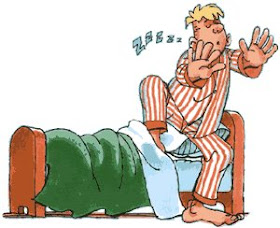–noun
1.
the act or state of walking, eating, or performing other motor acts while asleep, of which one is unaware upon awakening; somnambulism.
2.
of or pertaining to the state of walking while asleep; somnambulistic.
In the last week he has attempted to go to the bathroom in my craftroom and get his stuffed animal from the garage (both in the middle of the night). Thank goodness I was parked in the prime location to catch him on both occasions, before disaster struck. Of course, if you ask him about this, he'll deny, deny, deny. But, the 2nd time, I had my wits enough about me to capture a few photos for evidence.


Hours after bedtime, do you find your little one wandering the hall looking dazed and confused? If you have a sleepwalking child, you're not alone. It can be unnerving to see, but sleepwalking is very common in kids and most sleepwalkers only do so occasionally and outgrow it by the teen years. Still, some simple steps can keep your young sleepwalker safe while traipsing about.
- lack of sleep or fatigue
- interrupted sleep
- illness or fever
- certain medications
- stress (sleepwalking is rarely caused by an underlying emotional or psychological problem)
Behaviors During Sleepwalking
Of course, getting out of bed and walking around while still sleeping is the most obvious sleepwalking symptom. But young sleepwalkers may also:
- sleeptalk
- be hard to wake up
- seem dazed
- be clumsy
- not respond when spoken to
- sit up in bed and go through repeated motions, such as rubbing their eyes or fussing with their pajamas
- Also, sleepwalkers' eyes are open, but they don't see the same way they do when they're awake and they often think they're in different rooms of the house or different places altogether.
- Sometimes, these other conditions may accompany sleepwalking:
sleep apnea (brief pauses in breathing while sleeping)
bedwetting (enuresis)
night terrors.
Is Sleepwalking Harmful?
Most sleepwalkers don't sleepwalk often, so it's not usually a serious problem. However, sleepwalking episodes can be hazardous when they're frequent or intense. Why? Because sleepwalking kids aren't awake and may not realize what they're doing, such as walking down stairs or opening windows.
Sleepwalking is not usually a sign that something is emotionally or psychologically wrong with a child. And it doesn't cause any emotional harm. Sleepwalkers tend to go back to bed on their own and probably won't even remember the nighttime stroll.
How to Keep a Sleepwalker Safe
Although sleepwalking isn't dangerous by itself, it's important to take precautions so that your sleepwalking child is less likely to fall down, run into something, walk out the front door, or drive (if your teen is a sleepwalker).
- To help keep your sleepwalker out of harm's way:
- Don't awaken a sleepwalker because this might scare your child. Instead, gently guide him or her back to bed.
- Lock the windows and doors, not just in your child's bedroom but throughout your home, in case your young sleepwalker decides to wander. You may consider extra locks or child safety locks on doors. Keys should be kept out of reach for kids who are old enough to drive.
- To prevent falls, don't let your sleepwalker sleep in a bunk bed.
- Remove sharp or breakable things from around your child's bed.
- Keep dangerous objects out of reach.
- Remove obstacles from your child's room and throughout your home to prevent a stumble. Especially eliminate clutter on the floor (i.e., in your child's bedroom or playroom).
- Install safety gates outside your child's room and/or at the top of any stairs.
Other Ways to Help a Sleepwalker
Unless the episodes are very regular or your child is repeatedly engaging in dangerous sleepwalking behaviors, there's no reason to treat sleepwalking. But if the sleepwalking is frequent or your child hasn't outgrown it by the early teen years, talk to your doctor.
For kids who sleepwalk often, doctors may recommend a treatment called scheduled awakening. This disrupts the sleep cycle enough to help stop sleepwalking. In rare cases, a doctor may prescribe medication to help a child sleep.
Other ways to help minimize your child's sleepwalking episodes:
- Have your child relax at bedtime by listening to soft music or relaxation tapes.
- Establish a regular sleep and nap schedule and stick to it — both nighttime and wake-up time.
- Make your child's bedtime earlier. This can improve excessive sleepiness.
- Don't let kids drink a lot in the evening and be sure they go to the bathroom before going to bed. (A full bladder can contribute to sleepwalking.)
- Avoid caffeine near bedtime.
- Make sure your child's bedroom is quiet, cozy, and conducive to sleeping. Keep noise to a minimum while your child is trying to sleep (at bedtime and naptime).
The next time you encounter your nighttime wanderer, don't panic. Simply maneuver your child back to the safety and comfort of his or her bed. Then you can both probably have a good laugh about it in the morning.

Oh my gosh!! Those pictures!! haha. He looks MAD in the second one. I can't believe the flash didn't wake him up! That is so crazy, I love all the tips though...I think I would stress if I had a sleepwalking child. Way to do your research!
ReplyDeletehahahaha I hope he believes you now! that was a great post! :)
ReplyDeleteThat's crazy! Good idea to capture it on "film".
ReplyDelete